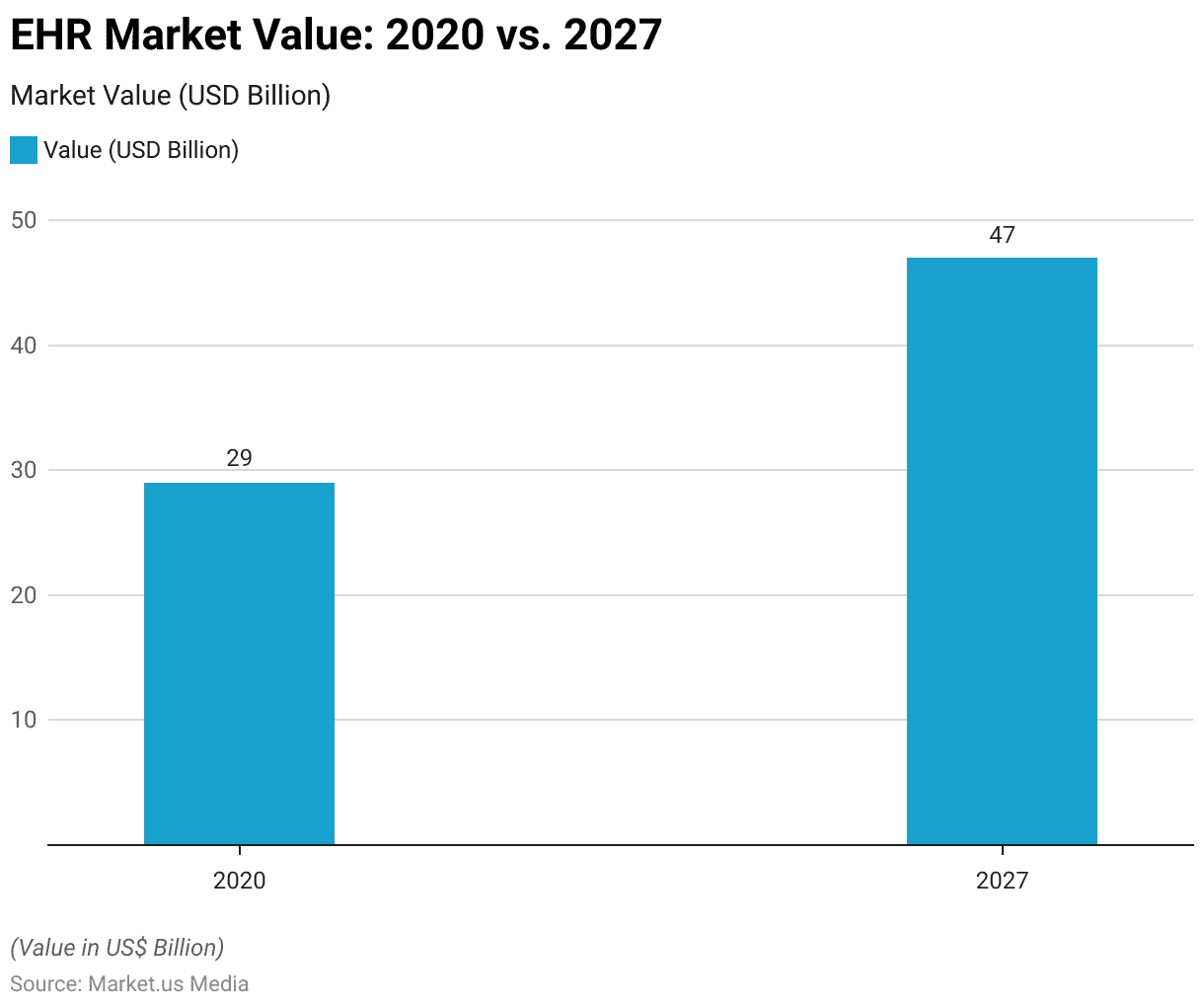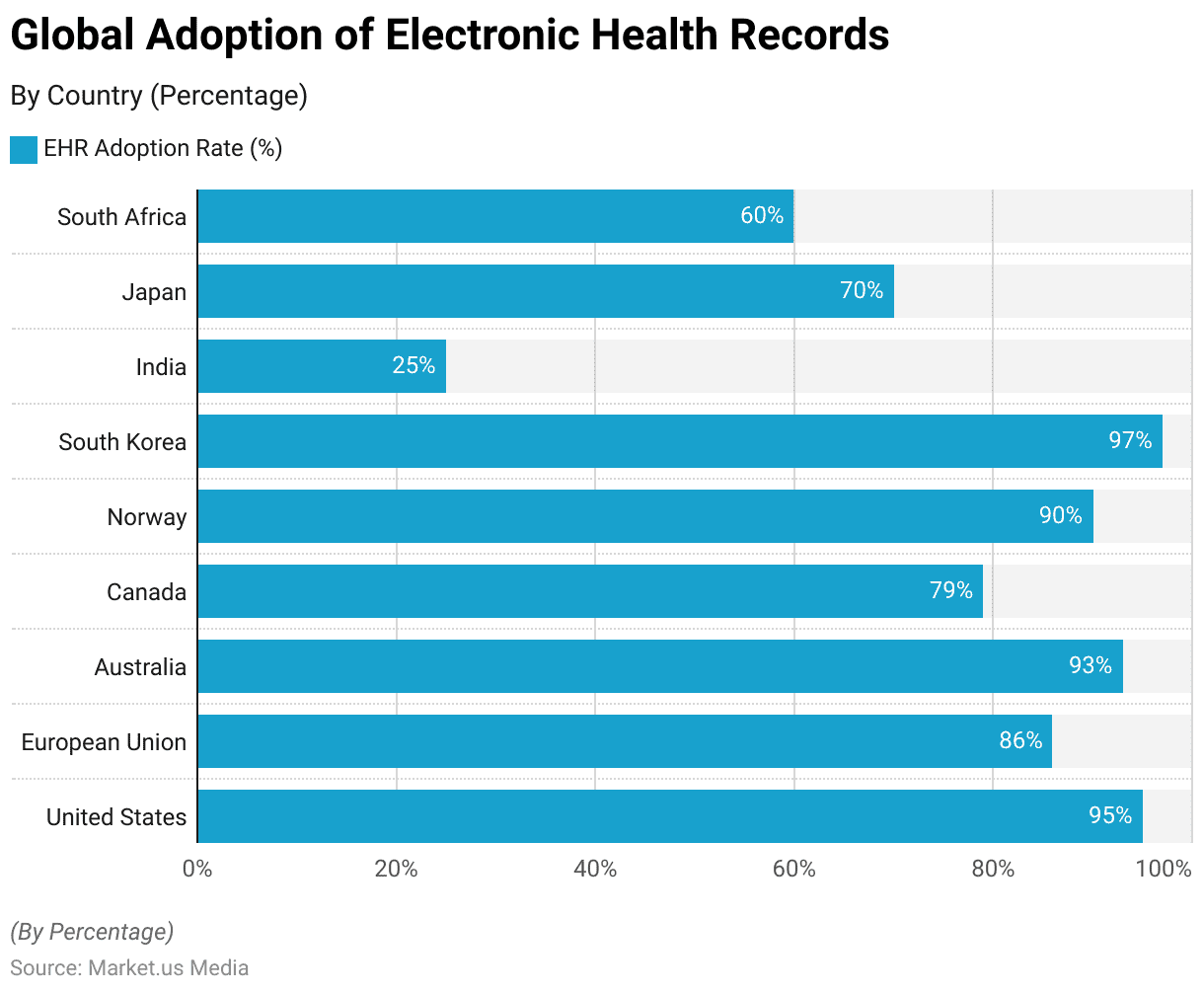According to Electronic Health Records Statistics, The adoption and utilization of EHR systems have seen significant growth in recent years due to various factors such as government initiatives, advancements in technology, and the increasing need for streamlined healthcare processes.
As EHRs become more prevalent, they offer immense benefits in terms of improved patient outcomes, increased efficiency, and enhanced research opportunities.
Table of Contents
Editor’s Choice
- eHealth market size is expected to be worth around USD 393.6 billion by 2032
- The global electronic health records market size is expected to grow to USD 43.62 billion by 2032 from USD 27.74 billion in 2021. It is expected to grow at a 4.2% CAGR from 2023 to 2032.
- Over 90% of hospitals in the United States have adopted EHR systems as of 2021.
- In a survey, 85% of healthcare providers reported that using EHRs improved patient care quality.
- EHR use has increased the efficiency of healthcare providers, with 75% reporting faster access to patient information.
- The majority of patients (82%) feel that EHRs enhance communication between healthcare providers and lead to better care coordination.
- EHR adoption rates in ambulatory care settings have steadily increased, with around 86% of office-based physicians using EHRs in 2021.
- According to a study, EHR implementation has led to an average reduction of 70% in medication errors.
- Data security remains a concern, as 53% of healthcare data breaches are attributed to EHR incidents.
- In 2020, the size of the electronic health records (EHR) market worldwide was valued at approximately 29 billion U.S. dollars. By 2027, the market size of EHRs globally was forecast to reach over 47 billion U.S. dollars.

Global Adoption of Electronic Health Records
- Over 95% of hospitals in the United States have adopted EHR systems.
- The global EHR market is projected to reach $40.39 billion by 2027.
- In the European Union, around 86% of healthcare professionals use EHRs in their practices.
- Australia has achieved an EHR adoption rate of approximately 93% in primary care settings.
- Canada has seen a steady increase in EHR adoption, reaching 79% of primary care providers by 2021.
- In 2021, more than 90% of hospitals in Norway were using EHRs to manage patient records.
- South Korea witnessed a significant surge in EHR adoption, with over 97% of hospitals implementing EHR systems.
- In India, EHR adoption has increased to approximately 25% in urban healthcare facilities.
- Japan has experienced a rise in EHR adoption, with around 70% of medical institutions utilizing digital health records.
- In South Africa, the adoption of EHRs has grown to 60% among healthcare providers.
- Developing countries adopting EHR systems have seen a 30% increase in healthcare efficiency, leading to better resource utilization.
- Developing nations like India and Brazil are investing in telemedicine and mobile EHR solutions to extend healthcare access in rural areas.
- Physicians in countries with high EHR adoption save an average of 3.5 hours per week on administrative tasks.

Benefits of Electronic Health Records
- Improved Patient Safety: EHRs reduce medical errors by up to 48.8%.
- Enhanced Efficiency: EHR implementation leads to 86% faster access to patient records.
- Cost Savings: Healthcare facilities can save up to $5 billion annually with EHR adoption.
- Better Care Coordination: EHRs improve care coordination, resulting in 30% fewer hospital readmissions.
- Increased Patient Engagement: EHR use correlates with a 60% rise in patient engagement.
- Time Savings: Physicians save an average of 5 hours per week with EHR usage.
- Access to Clinical Decision Support: EHRs provide clinical decision support to 91% of healthcare providers.
- Research Advancements: EHR data contributes to over 80% of medical research.
- Public Health Initiatives: EHRs aid in tracking and managing outbreaks, supporting 76% of public health agencies.
- Reduction in Duplicate Tests: EHRs cut down on redundant tests, leading to a 30% decline.
EHR Usage Statistics among Healthcare Providers
- As of 2021, approximately 93% of office-based physicians in the United States use some form of Electronic Health Records (EHR) system in their practices.
- Among hospitals in the United States, EHR adoption has reached 96%, indicating near-universal usage among healthcare facilities.
- Large hospitals have a higher EHR adoption rate, with 97% of facilities with more than 300 beds using EHR systems.
- In contrast, smaller hospitals have a slightly lower adoption rate, with 88% of facilities with 1-49 beds utilizing EHR systems.
- Among ambulatory care settings, such as outpatient clinics and medical offices, EHR usage has steadily increased, with approximately 90% of facilities adopting EHRs by 2021.
- In terms of healthcare specialties, EHR adoption varies, with higher rates seen in primary care (94%) and internal medicine (95%) practices.
- Pediatric and obstetrics-gynecology practices have shown slightly lower EHR adoption rates, with 85% and 89% respectively.
- Across healthcare settings, the adoption of fully functional EHRs has grown, with 83% of hospitals and 75% of office-based physicians using systems capable of meeting meaningful use criteria.
- Specialty-specific EHR adoption rates have seen an increase, with dermatology and cardiology showing significant growth in recent years, reaching 80% and 89% respectively.
Impact of EHR on Patient Outcomes
- Reduced Medication Errors: EHR implementation has been associated with a 48% reduction in medication errors, contributing to enhanced patient safety and quality of care
- Improved Chronic Disease Management: Patients with chronic conditions have seen a 25% improvement in disease management when their healthcare providers utilize EHR systems for care coordination and monitoring.
- Decreased Hospital Readmissions: Hospitals using EHRs have experienced a 20% reduction in readmission rates, resulting in better patient outcomes and cost savings.
- Enhanced Preventive Care: EHRs have enabled a 30% increase in adherence to preventive care guidelines, leading to early detection and intervention for various health conditions.
- Faster Access to Critical Information: EHR implementation has reduced the time required to access patient information by up to 80%, allowing healthcare professionals to make quicker and more informed decisions.
EHR Security and Privacy
- 87% of healthcare organizations have experienced a data breach involving EHRs, highlighting the ongoing concerns regarding data security.
- Medical records are among the most valuable data types targeted by cybercriminals, with a stolen medical record selling for up to $250 on the dark web.
- Approximately 60% of healthcare data breaches are caused by insider threats, emphasizing the importance of employee training and awareness.
- 67% of healthcare organizations have experienced a ransomware attack, where cybercriminals encrypt EHR data and demand a ransom for its release.
- Despite the risks, only 36% of healthcare organizations use encryption to protect patient data, leaving a significant portion of EHRs vulnerable to unauthorized access.
- The average cost of a healthcare data breach is $7.13 million, making it financially detrimental for organizations that fail to secure EHRs adequately.
Discuss your needs with our analyst
Please share your requirements with more details so our analyst can check if they can solve your problem(s)



